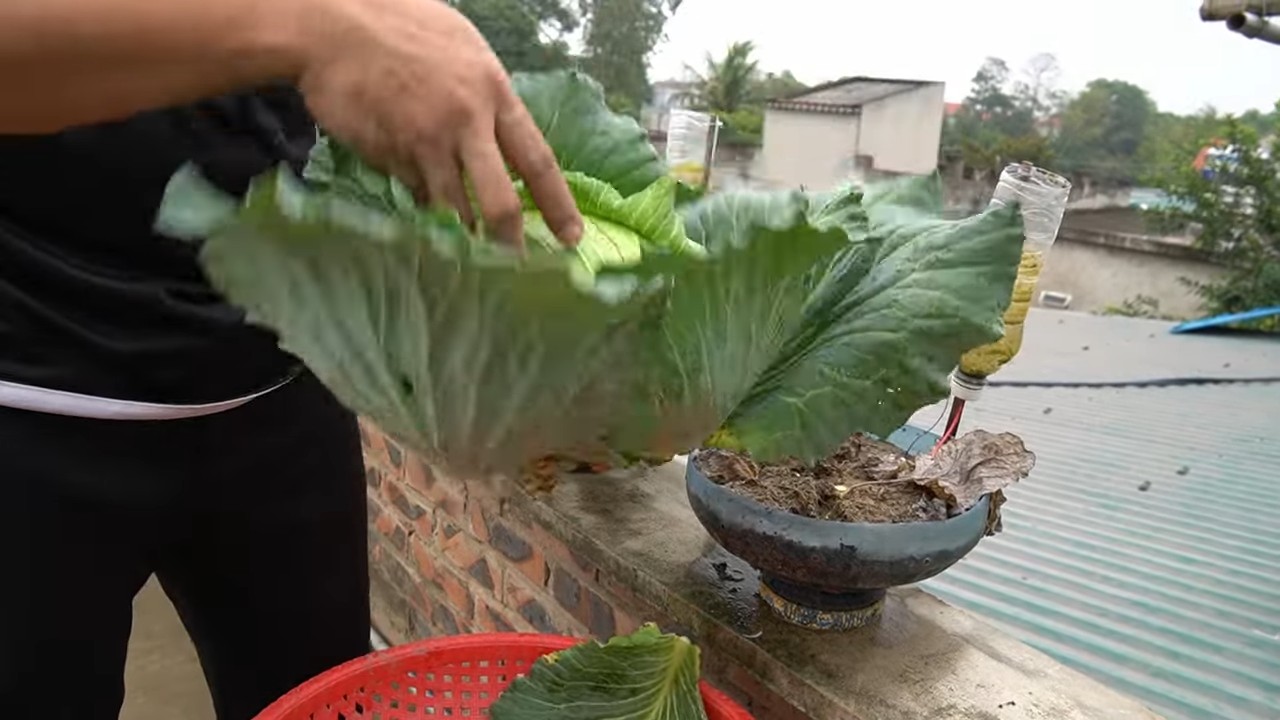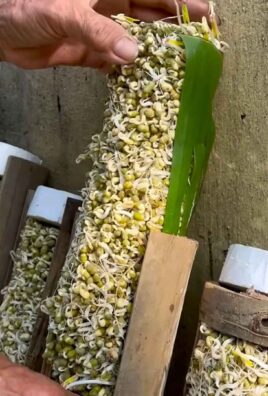Balcony Cabbage Growing Tips: Dreaming of fresh, homegrown cabbage but short on space? You’re not alone! Many urban dwellers crave the satisfaction of cultivating their own food, and thankfully, you don’t need acres of land to make it happen. This article is your ultimate guide to mastering the art of balcony cabbage growing, transforming your limited outdoor space into a thriving mini-farm.
Cabbage, a staple in cuisines worldwide, boasts a rich history dating back thousands of years. From ancient Rome, where it was prized for its medicinal properties, to medieval Europe, where it sustained communities through harsh winters, cabbage has always been a symbol of resilience and nourishment. Today, we’re bringing this hardy vegetable to the modern balcony garden!
Why should you try these balcony cabbage growing tips? Well, imagine stepping onto your balcony and harvesting crisp, flavorful cabbage for your next meal. Not only will you enjoy the unparalleled taste of homegrown produce, but you’ll also reduce your carbon footprint, save money, and experience the therapeutic benefits of gardening. Plus, with the right techniques, even a small balcony can yield a surprisingly bountiful harvest. I’m excited to share my favorite DIY tricks and hacks that will help you succeed, even if you’re a complete beginner. Let’s get started and unlock the secrets to successful balcony cabbage growing!

Balcony Cabbage: Your Own Little Vegetable Garden on the Balcony
Hey you! Do you also feel like harvesting fresh vegetables right on your doorstep? Then you’ve come to the right place! I’ll show you how you can easily grow cabbage on your balcony. It’s easier than you think and a lot of fun!
Why Cabbage on the Balcony?
Cabbage is not only super healthy but also surprisingly easy to grow, even if you don’t have a garden. Plus, it’s great to know where your food comes from and that it’s free of unnecessary pesticides. And let’s be honest, homegrown cabbage just tastes better!
Which Cabbage Varieties are Suitable for the Balcony?
Not every cabbage feels at home on the balcony. Here are a few varieties that I can particularly recommend:
- Dwarf or Mini Cabbage: These varieties are specially bred for growing in pots and stay nice and small.
- Cauliflower: Cauliflower can also thrive in a pot, but make sure it has enough space.
- Broccoli: Similar to cauliflower, broccoli needs enough room to develop.
- Kale: Kale is robust and low-maintenance, perfect for beginners.
- Head Lettuce: Although not a “true” cabbage, head lettuce belongs to the family and can be grown wonderfully in a pot.
- Radishes: Radishes are fast-growing and can serve as “fillers” between the cabbage plants.
What you need for your balcony cabbage:
- Pots or containers: Make sure they are of a sufficient size (at least 20 liters per cabbage plant, depending on the variety).
- High-quality potting soil: Special vegetable soil or a mixture of garden soil, compost, and sand is best.
- Cabbage plants or seeds: You can buy young plants or start the seeds yourself.
- Fertilizer: Organic fertilizer is ideal, e.g., compost, horn shavings, or vegetable fertilizer.
- Watering can or hose: For regular watering.
- Scissors or knife: For harvesting.
- Possibly: A slug fence or pellets to protect your plants from slugs.
Step-by-Step Guide: Growing Cabbage on the Balcony
1. Preparation:
- Prepare the pots: Clean your pots thoroughly and ensure good drainage. This means that excess water can run off. To do this, place a layer of clay shards or gravel at the bottom of the pot.
- Fill with soil: Fill the pots with the potting soil. Leave a rim of about 5 cm at the top.
- Choose a location: Cabbage needs a lot of sun! Choose a sunny spot on your balcony where the plants will get at least 6 hours of sun per day.
2. Planting or Sowing:
- Planting: If you have bought young plants, dig small holes in the soil that are large enough to accommodate the root balls. Carefully place the plants in and press the soil down lightly. Make sure that the root crown (the transition between the root and the stem) is not covered with soil.
- Sowing: If you want to start the seeds yourself, sow them in seed trays or small pots. Cover the seeds lightly with soil and keep them moist. After a few weeks, you can transplant the young plants into the larger pots.
- Mind the spacing: Make sure the plants have enough distance from each other. Depending on the variety, you should maintain a distance of 30-50 cm.
3. Care:
- Watering: Cabbage needs regular water, especially during the growth phase. It’s best to water in the morning or evening when the sun isn’t shining. Avoid waterlogging, as this can lead to root rot. The soil should always be slightly moist, but not wet.
- Fertilizing: Fertilize your cabbage plants regularly, about every two weeks, with organic fertilizer. This ensures healthy growth and a bountiful harvest.
- Pest control: Cabbage is susceptible to pests like cabbage white butterflies, aphids, and slugs. Check your plants regularly and remove pests by hand if necessary. You can also use natural pesticides, e.g., nettle tea or neem oil. A slug fence can also help protect your plants from slugs.
- Pruning suckers: With some cabbage varieties, such as Brussels sprouts, you should remove the side shoots (suckers) to promote the growth of the main buds.
- Supporting: If your cabbage plants get very large, it may be useful to support them with stakes so they don’t tip over.
4. The Harvest:
- Harvesting time: The harvesting time depends on the cabbage variety. Cauliflower and broccoli are ready for harvest when the heads are firm and closed. Kale can be harvested as soon as the leaves are large enough. Brussels sprouts are harvested when the sprouts are firm and closed.
- Harvesting method: Cut the cabbage heads or leaves with a sharp knife. With kale, you can harvest the outer leaves as needed.
- Storage: Fresh cabbage keeps in the refrigerator for a few days. You can also freeze it to make it last longer.
Additional Tips for Your Balcony Cabbage:
- Companion planting: Plant cabbage together with other plants that support each other. Good neighbors for cabbage are, for example, marigolds, nasturtiums, sage, and thyme. These plants can repel pests and promote the growth of the cabbage.
- Crop rotation: Do not plant cabbage in the same location every year. Rotate the plant species to prevent diseases and pests.
- Soil improvement: Improve the soil quality regularly by incorporating compost or organic fertilizer.
- Observation: Observe your plants regularly to identify and fix problems early.
Common Problems and Solutions:
- Yellow leaves: Yellow leaves can be a sign of a nutrient deficiency. Fertilize your plants with a suitable fertilizer.
- Aphids: Aphids can be washed off with a jet of water or controlled with a natural pesticide.
- Cabbage white butterflies: Cabbage white butterflies lay their eggs on the cabbage leaves. Collect the eggs and caterpillars by hand or use a net to protect the plants.
- Slugs: Slugs can be controlled with slug pellets or a slug fence.
Conclusion:
With a little patience and care, you can achieve a bountiful cabbage harvest on your balcony. It’s a great feeling to harvest fresh vegetables right on your doorstep and to know that they are free of unnecessary pesticides. So, what are you waiting for? Get started and transform your balcony into a small vegetable garden! Happy gardening!

Conclusion
So, there you have it! Growing cabbage on your balcony isn’t just a whimsical idea; it’s a genuinely achievable and rewarding experience. We’ve walked you through the essential steps, from selecting the right varieties to warding off common pests, all tailored for the unique environment of a balcony garden. But why should you actually take the plunge and try this out?
Firstly, consider the sheer satisfaction of harvesting your own fresh, crisp cabbage just steps from your kitchen. Imagine the vibrant green leaves, bursting with flavor, ready to be transformed into delicious slaws, stir-fries, or hearty soups. Store-bought cabbage simply can’t compare to the taste and texture of homegrown produce. Plus, you’ll know exactly what went into growing it – no harsh chemicals or mystery ingredients.
Secondly, balcony cabbage growing is a fantastic way to maximize your limited space. Even if you don’t have a sprawling backyard, you can still enjoy the benefits of gardening. Cabbage plants are relatively compact and can thrive in containers, making them perfect for urban dwellers. It’s a productive and aesthetically pleasing way to green up your balcony.
Thirdly, let’s talk about the environmental benefits. By growing your own food, you’re reducing your carbon footprint by minimizing transportation and packaging. You’re also contributing to a more sustainable lifestyle and connecting with nature in a meaningful way.
But the best part is the versatility. Feel free to experiment with different cabbage varieties. Red cabbage adds a beautiful splash of color to your balcony and a slightly peppery flavor to your dishes. Savoy cabbage offers a milder, sweeter taste and crinkled leaves that are perfect for stuffing. Chinese cabbage (Napa cabbage) is a great choice for Asian-inspired cuisine. You can even try growing miniature cabbage varieties for a fun and unique twist.
Consider companion planting to further enhance your balcony garden. Marigolds can help deter pests, while herbs like rosemary and thyme can attract beneficial insects. Interplanting with lettuce or spinach can maximize space and provide a continuous harvest.
Don’t be afraid to get creative with your containers. Use repurposed buckets, old tires, or even hanging baskets to add a touch of personality to your balcony garden. Just make sure your containers have adequate drainage to prevent waterlogging.
Balcony cabbage growing is more than just a gardening project; it’s an opportunity to connect with nature, enjoy fresh, healthy food, and create a beautiful and productive outdoor space. It’s a chance to learn new skills, experiment with different techniques, and share your bounty with friends and family.
So, what are you waiting for? Grab some seeds or seedlings, gather your supplies, and get ready to embark on a rewarding gardening adventure. We’re confident that you’ll be amazed at how easy and enjoyable it is to grow your own cabbage on your balcony.
We’d love to hear about your experiences! Share your photos, tips, and challenges in the comments below. Let’s create a community of balcony cabbage growers and inspire others to embrace the joys of urban gardening. Happy growing!
Frequently Asked Questions (FAQ)
What is the best time of year to start growing cabbage on my balcony?
The best time to start growing cabbage depends on your climate. Cabbage is a cool-season crop, so it thrives in temperatures between 60°F and 70°F (15°C and 21°C). In most regions, you can plant cabbage in early spring for a summer harvest or in late summer for a fall or winter harvest. If you live in a warmer climate, you may be able to grow cabbage year-round. Check your local planting calendar for specific dates. Starting seeds indoors 6-8 weeks before the last expected frost is also a good option, especially in colder climates, to give your plants a head start.
What size container do I need for growing cabbage on my balcony?
Cabbage plants need plenty of room to grow, so choose a container that is at least 12 inches (30 cm) in diameter and 12 inches (30 cm) deep. Larger containers are even better, as they will provide more space for the roots to develop and help retain moisture. Make sure the container has drainage holes to prevent waterlogging. A five-gallon bucket or a large planter box works well.
What kind of soil should I use for growing cabbage in containers?
Use a well-draining potting mix that is rich in organic matter. Avoid using garden soil, as it can be too heavy and compact for containers. You can amend your potting mix with compost, aged manure, or other organic materials to improve its fertility and drainage. A slightly acidic soil pH of around 6.0 to 6.8 is ideal for cabbage.
How often should I water my cabbage plants?
Cabbage plants need consistent moisture, especially during hot weather. Water deeply whenever the top inch of soil feels dry to the touch. Avoid overwatering, as this can lead to root rot. Check the soil moisture regularly and adjust your watering schedule accordingly. Mulching around the base of the plants can help retain moisture and suppress weeds.
What are some common pests and diseases that affect cabbage plants, and how can I prevent them?
Common pests that affect cabbage plants include cabbage worms, aphids, and flea beetles. You can prevent these pests by covering your plants with row covers, handpicking them off the plants, or using organic insecticides like neem oil or insecticidal soap. Common diseases include clubroot and black rot. You can prevent these diseases by practicing crop rotation, using disease-resistant varieties, and ensuring good drainage. Regularly inspect your plants for signs of pests or diseases and take action promptly.
How much sunlight do cabbage plants need?
Cabbage plants need at least 6 hours of sunlight per day to thrive. Choose a sunny spot on your balcony where your plants will receive plenty of direct sunlight. If you live in a very hot climate, you may need to provide some afternoon shade to prevent the leaves from scorching.
How do I fertilize my cabbage plants?
Cabbage plants are heavy feeders and need regular fertilization. Use a balanced fertilizer that is high in nitrogen, phosphorus, and potassium. You can also use organic fertilizers like compost tea or fish emulsion. Fertilize your plants every 2-3 weeks during the growing season. Follow the instructions on the fertilizer label for application rates.
How long does it take for cabbage to mature?
Cabbage typically takes 60-100 days to mature, depending on the variety. You can harvest your cabbage when the head is firm and tightly packed. To harvest, simply cut the head off the plant at the base. You can leave the roots in the ground, and they may produce smaller side shoots that you can harvest later.
Can I grow cabbage in the winter on my balcony?
In many regions, yes! If you live in a mild climate, you can grow cabbage throughout the winter. Choose cold-hardy varieties and protect your plants from frost by covering them with blankets or moving them to a sheltered location. Even in colder climates, you might be able to extend the growing season by using cold frames or greenhouses on your balcony.
What are some good companion plants for cabbage?
Good companion plants for cabbage include marigolds, rosemary, thyme, dill, and nasturtiums. These plants can help deter pests, attract beneficial insects, and improve the flavor of your cabbage. Avoid planting cabbage near members of the nightshade family, such as tomatoes, peppers, and eggplants, as they can compete for nutrients and attract similar pests.





Leave a Comment